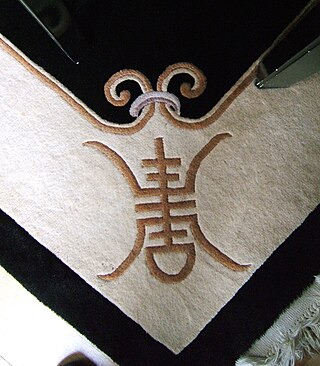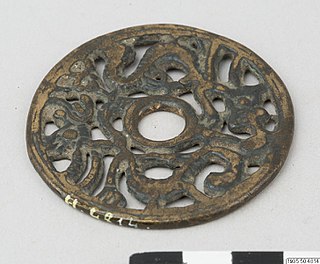Chen Shou, courtesy name Chengzuo (承祚), was a Chinese historian, politician, and writer who lived during the Three Kingdoms period and Jin dynasty of China. Chen Shou is best known for his most celebrated work, the Records of the Three Kingdoms (Sanguozhi), which records the history of the late Eastern Han dynasty and the Three Kingdoms period. Chen Shou wrote the Sanguozhi primarily in the form of biographies of notable persons of those eras. Today, Chen's Records of the Three Kingdoms is part of the Twenty-Four Histories canon of Chinese history.

Ma Liang (187–222), courtesy name Jichang, was an official serving under the warlord Liu Bei during the late Eastern Han dynasty of China. Since he was young, Ma Liang was famous for his exceptional talent, with Chen Shou describing him as one of Shu's best officials. However, he was killed in battle at the age of 35 years during the Battle of Xiaoting. He served in the state of Shu Han as one of the founding emperor Liu Bei's Palace Attendants during the early Three Kingdoms period and was the elder brother of Ma Su.
Empress Quan, also known as Quan Huijie, was an empress of the state of Eastern Wu during the Three Kingdoms period of China. She was married to Sun Liang, the second emperor of Wu.
Li Shou, courtesy name Wukao (武考), formally Emperor Zhaowen of (Cheng) Han ( 漢昭文帝), was an emperor of the Di-led Chinese Cheng-Han dynasty. He was the cousin of Cheng-Han's founding emperor Li Xiong, but after he overthrew Li Xiong's son Li Qi in 338, he disassociated himself from Li Xiong's regime by renaming the state from Cheng to Han, and further setting up a different imperial ancestral temple. Traditional historians, however, did not consider his regime a separate state and treated the succession from Li Xiong to Li Shou's son Li Shi as a single Cheng-Han state. Li Shou was initially known for lenience and thriftiness—the same virtues commonly associated with Li Xiong—but later imitated the ruling style of Shi Hu the emperor of Later Zhao by ruling harshly and extravagantly, greatly inflicting burdens on the people and damaging the Cheng-Han state.

King Wen of Zhou was the posthumous title given to Ji Chang, the patriarch of the Zhou state during the final years of Shang dynasty in ancient China. Ji Chang himself died before the end of the Zhou-Shang War, and his second son Ji Fa completed the conquest of Shang following the Battle of Muye, and posthumously honored him as the founder of the Zhou dynasty. Many of the hymns of the Classic of Poetry are praises to the legacy of King Wen. Some consider him the first epic hero of Chinese history.
Luo Xian, courtesy name Lingze, was a military general of Shu Han in the Three Kingdoms period of China. After the fall of Shu in 263, he continued serving under the Cao Wei state, then the succeeding Jin dynasty in 266. He is best known for defending his position at Yong'an for about six months against attacks from Shu's former ally state Wu after the fall of Shu.

Du Yu, courtesy name Yuankai, was a Chinese classicist, military general, and politician of the state of Cao Wei during the late Three Kingdoms period and early Jin dynasty.

The Sanxing are the gods of the three celestial bodies considered essential in Chinese astrology and mythology: Jupiter, Ursa Major, and Canopus. Fu, Lu, and Shou, or Cai, Zi and Shou (財子壽) are also the embodiments of Fortune (Fu), presiding over the planet Jupiter, Prosperity (Lu), presiding over Mizar, and Longevity (Shou), presiding over Canopus. They have emerged from Chinese folk religion. Their iconic representation as three, old, bearded, wise men dates back to the Ming dynasty, when the gods of the three stars were represented in human form for the first time. They are sometimes identified with other deities of the Chinese religion or of Taoism.

Yansheng Coins, commonly known as Chinese numismatic charms, refer to a collection of special decorative coins that are mainly used for rituals such as fortune telling, Chinese superstitions, and Feng shui. They originated during the Western Han dynasty as a variant of the contemporary Ban Liang and Wu Zhu cash coins. Over the centuries they evolved into their own commodity, with many different shapes and sizes. Their use was revitalized during the Republic of China era. Normally, these coins are privately funded and cast by a rich family for their own ceremonies, although a few types of coins have been cast by various governments or religious orders over the centuries. Chinese numismatic charms typically contain hidden symbolism and visual puns. Unlike cash coins which usually only contain two or four Hanzi characters on one side, Chinese numismatic charms often contain more characters and sometimes pictures on the same side.

Fu Lu Shou Complex is a shopping centre built in 1983 located at Bugis, Singapore that specialises in Daoist and Buddhist religious paraphernalia.

Shòu is the Chinese word/character for "longevity".
Lu Kang (126–195), courtesy name Jining, was a Chinese politician who lived during the late Eastern Han dynasty of China.

Zhu Youyuan, was a prince of the Ming dynasty of China. He was the fourth son of the Chenghua Emperor.
Sima Yi (179–251) was a general, politician and regent of the state of Cao Wei (220–266) in the Three Kingdoms period (220–280) in China. Two of his sons, Sima Shi (208–255) and Sima Zhao (211–265), rose to power in the 250s and consecutively served as regents throughout the reigns of the last three Wei emperors. After Sima Zhao died in September 265, his son Sima Yan (236–290) forced the last Wei ruler, Cao Huan (246–303), to abdicate the throne in his favour in February 266, ending the Wei regime and establishing the Jin dynasty (266–420). This article contains the family trees of Sima Yi, his brothers, and their descendants up to Sima Yan's generation. For more details on the family trees of the Jin emperors, see Chinese emperors family tree (early)#Jin Dynasty and Chu.
Xun Yi, courtesy name Jingqian, was a Chinese politician of the state of Cao Wei in the Three Kingdoms period of China. After the fall of Wei, he continued serving under the Jin dynasty, which replaced Wei in 266. He was the sixth son of Xun Yu.
Liu Zan (183–255), courtesy name Zhengming, was a military general of the state of Eastern Wu during the Three Kingdoms period of China. He previously served under the warlord Sun Quan in the late Eastern Han dynasty.
Du Wei, courtesy name Guofu, was a scholar who rejected service, including via faking of poor health, before eventually becoming an official of the state of Shu Han during the Three Kingdoms period of China.

Lock charms are Chinese numismatic charms shaped like ancient Chinese security locks. Their shape resembles a basket or in most cases the Chinese character for "concave" (凹). The pendants tend to be flat, without any moving parts, or the functionality of the locks they symbolize. They are decorated with both Chinese characters and symbols. Like other types of Chinese numismatic charms, lock charms are meant to protect the wearers from harm, misfortune, and evil spirits, and to bless them with good luck, longevity, and a high rank. In particular, this talisman is meant for young boys, to help "lock" them to the earth, to guard them from death.

Open-work charms are a type of Chinese, Japanese, Korean, and Vietnamese numismatic charms characterised by irregularly shaped "holes" or "openings" between their design elements known as openwork. The design of the amulets represent yin while the holes represent yang and their general purpose was to attract good fortune and ward off evil spirits and misfortune. Unlike most other types of Chinese numismatic charms which usually tend to have square center holes if they’re holed, open-work charms tend to almost exclusively have round center holes though open-work charms with square center holes are known to exist and certain thematic open-work charms that feature human-made constructions mostly told to have square holes. Another distinctive feature of open-work charms is that they’re almost purely based on illustrative imagery and only a small minority of them contain legends written in Hanzi characters. While most other forms of Chinese numismatic charms are made from brass open-work charms are predominantly made from bronze.
Chinese auspicious ornaments in textile and clothing refers to any form of Chinese auspicious ornaments, which are used to decorate various forms of Chinese textile and clothing, fashion accessories, and footwear in China since the ancient times. Chinese auspicious ornaments form part of Chinese culture and hold symbolic meanings. In ancient China, auspicious ornaments were often either embroidered or woven into textile and clothing. They are also used on religious and ritual clothing and in Xifu, Chinese opera costumes. Auspicious symbols and motifs continue to be used in present day China in industries, such as home textiles and clothing; they are also used in modern design packaging and interior design. Some of these Chinese auspicious ornaments were also culturally appropriated by European countries during the era of Chinoiserie, where they became decorative patterns on fashionable chinoiserie fashion and textiles.













